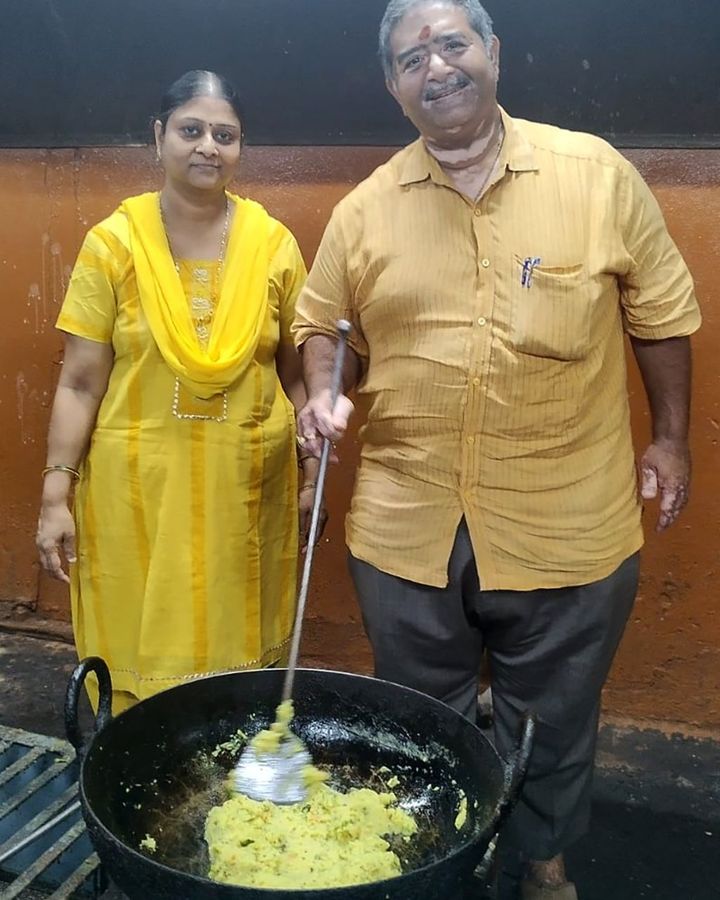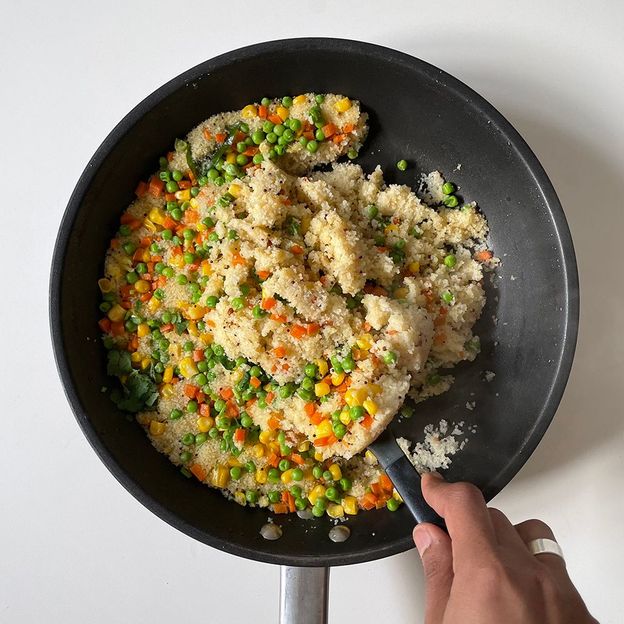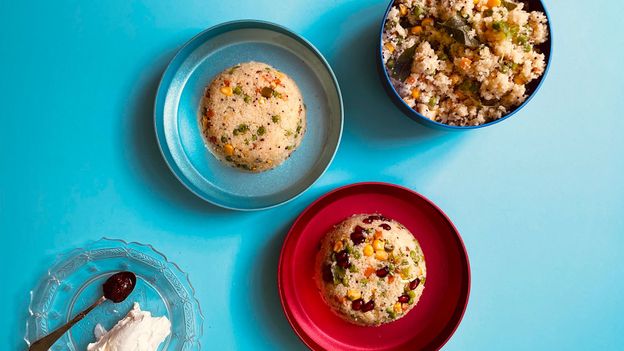For millions of Indians, a day can start or end with a plate of warm rava upma, savoury semolina grains cooked to a tender, fluffy consistency. A classic rava upma is made from semolina, salt, vegetables and a South Indian-style seasoning of mustard and black lentils, and served with yogurt, pickles or bananas as accompaniments. A drizzle of ghee simply elevates this dish to a whole other level. Given how easy it is to put together upma, it appears at the family table as a practical dish that suits the rhythm of work-life balance.
It’s also popular outside of the home. “One plate upma, one filter coffee without sugar, please!” is a typical breakfast and dinner order in restaurants and bustling tiffin houses across South India.
Upma, from the Tamil word uppu-mavu (literally, “salt-flour”), is an archaic preparation of broken rice grains or flour cooked with salt, water and sometimes a dash of yoghurt. It’s made across the subcontinent with vernacular variations like uppittu in the state of Karnataka, uppitt in Maharashtra and uppudu pindi in Andhra. By the time Indians began recording their recipes in cookbooks in the late 19th Century, like the Pakashastra published in Madras in 1891, such rice-based upmas were called sada upma , or ordinary upma.
It was during periods of rice shortage, most prominently during World War Two, that the British pushed and popularised wheat, particularly semolina (the cracked endosperm of wheat), encouraging South Indians to treat it like rice. Semolina was very affordable and quickly became a kitchen staple all over India. In the last century, the dish had ultimately been adapted to use rava (wheat semolina), hence the name rava upma .
Haritha Sheshadri of Sri Krishna Sai Caterers, a multi-generational wedding caterer in Hyderabad adds, “Upma is an inexpensive ingredient ubiquitously available and simple to prepare, which has made it well accepted amongst people, transcending religion, caste and class barriers.”

Haritha and Hariharan Seshadri prepare rava upma for weddings (Credit: Kudurupaka Srinivas)
Ingenious Indian housewives invented many upma variations, including bread upma , which uses up small pieces of stale bread; semiya upma made with roasted vermicelli; and milletupma with millets replacing the semolina. Flavours borrowed from other rice preparations resulted in dishes like lemon upma, tamarind-based puli upma , and the spiced masala upma . Nevertheless, rava upma remains a beloved classic.
A celebration dish
Not just served in homes and restaurants, rava upma is a standard dish at South Indian weddings. “Upma is a dish that tastes good, everyone can afford [it], and it’s an easy crowd pleaser,” said Haritha and Hariharan Seshadri of Sri Krishna Sai Caterers, a multi-generational wedding caterer in Hyderabad.”It is easy to make in large quantities and does not need much planning… It also requires little in terms of accompaniments – guests are happy to have it paired with a sprinkling of sugar, a banana, some ghee or pickles.”
Making rava upma starts with roasting semolina slowly over medium heat until it looks sandy; this brings out the phenomenal flavours of ripe wheat. Once toasted, the semolina is set aside, and black lentils or urad dal are toasted to a golden brown in the skillet in hot oil, for a nutty aroma. Such a seasoning is a unique aspect to almost all South Indian preparations. Mustard seeds follow with unruly spluttering, but you can quickly control this by throwing in chopped aromatics like ginger and chillies. At this point, nuts, raisins, chopped onions or garlic can be added too, depending on what you have on hand. Both frozen and fresh carrots, peas, corn and bell peppers work great, too. Chopped tomatoes give a moister result. Cubed potatoes, if used, need a little more time to cook in the pan before adding the roasted semolina back to the skillet.
Upma can be prepared up to this stage and chilled for up to a day. You can continue the cooking process with water just before serving, making it a perfect dish for weekday meals.
A few simple hints can help you easily master the most flavourful rava upma. It doesn’t have a specific texture, as some people like it soft like a dough, while others prefer it delicate and fluffy. An important thing to remember is that fine semolina makes a mushy upma, and a coarse semolina will make it fluffier.

Rava upma is made with roasted semolina, black lentils, aromatics and vegetables (Credit: Priya Mani)
Classic Semolina Upma recipe
By Haritha Sheshadri
serves 2
Ingredients
1 cup coarse semolina
2 tbsp neutral oil, such as vegetable
1 tsp urad dal (black lentils)
1 tsp black mustard seeds
a pinch of asafoetida , a spice from a giant variety of fennel
1 green chilli, seeded, chopped finely
one 2cm long piece of ginger, peeled and grated
4-5 curry leaves
1 medium carrot, diced
½ cup corn kernels or shelled peas
¾ tsp salt
2 cups water
a few coriander springs, chopped
2 tbsp ghee
Method
Step 1
In a heavy-bottomed skillet, roast the semolina over medium to high heat for about 5 minutes, stirring continuously, until it looks sandy. Set aside on a plate.
Step 2
In the same skillet, heat the oil and temper with lentils, mustard seeds and asafoetida, followed by the chopped green chili, grated ginger and curry leaves. Add the carrot and corn and sauté until just soft.
Step 3
Fold in the roasted semolina and salt and mix well. At this point, you can chill this mixture to be finished later in the day. Reheat well on medium heat before continuing.
Step 4
Add the water and mix well, so there are no clumps. Bring it to a boil, and quickly reduce the heat to low and cover with a lid. Turn off the heat and let it sit for ten minutes.
Step 5
Gently turn over the cooked grains. Add chopped coriander and drizzle with ghee. Dress your upma in a mould (e.g. a large cup), or simply spoon it on a plate. You can choose to remove the curry leaves before serving. Serve with thick yogurt or achaar , Indian-style pickles, readily available at most international grocers.
To make it for a crowd, increase the recipe proportionately and serve with a variety of pickles and toppings. Fried nuts, raisins, freshly grated coconut, and pomegranate seeds elevate upma from a simple weeknight fix to a party piece with wide appeal.
BBC.com’s World’s Table “smashes the kitchen ceiling” by changing the way the world thinks about food, through the past, present and future.
—
Join more than three million BBC Travel fans by liking us on Facebook , or follow us on Twitter and Instagram .
If you liked this story, sign up for the weekly bbc.com features newsletter called “The Essential List”. A handpicked selection of stories from BBC Future, Culture, Worklife and Travel, delivered to your inbox every Friday.

